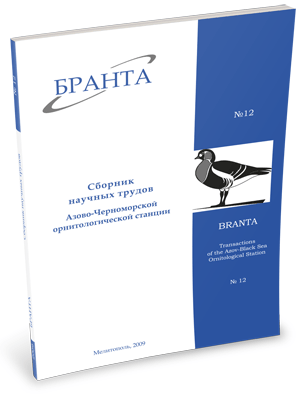
Transactions
of the Azov-Black Sea Ornithological Station



The initial period of autumn migration of birds on Tarkhankut Peninsula (2006-2007).
Diadicheva E.A., Maksalon L., Busel V.A.
The presented paper is based on the results of observations of autumn migration and catching of birds by mist nets (15.08-22.09.2006, and 22.08-9.10.2007) in tree-shrub thickets of the upper part of Ternovaya Gully (the vicinity of Olenevka Village, the Black Sea region of the Crimea; 45.25N 32.32E). In addition, some data of 1992, when the catching period was the longest (17.08-25.10), were used for comparison. In our paper we present a summarized analysis of species composition, sex and age structure and passage dynamics of the first waves of autumn migrants in the north-western coast of the Crimea.
During the autumn migration in tree-shrub habitats of TarkhankutPeninsula there regularly occur 27 species of passerine birds (Passeriformes) - the early migrants who start their passage in August (Table 1-2). Other 13 species are also early migrants, characterizing the avifauna of this area, but they occur not annually and in few numbers or are rare visitors. In addition, in September there begin the passage of 11 species of late migrants, more typical for the October period.
The highest rate of migration is observed for the period 3-12 September (pentad 50-51; Fig. 1).
The main list of dominating species (10 species) remains stable during the long-term period. Of them 5 species (willow warbler Phylloscopus trochilus, Red-breasted flycatcher Ficedula parva, Spotted Flycatcher Muscicapa striata, Blackcap Sylvia atricapilla andGardenWarbler Sylvia borin) are dominant in the migratory stream of Passeriformes throughout the migration period of August-September), 4 species (Red-backed Shrike Lanius collurio, Whitethroat Sylvia communis, Whinchat Saxicola rubetra, Thrush Nightingale Luscinia luscinia) – August and first half of September, and the Redstart Phoеnicurus phoenicurus – during the whole September.
These species may be proposed as a model to characterize the first half of autumn migration in the Western Crimea. For them a more detailed description of the passage dynamics is given (Table 3-11; Fig.4-5), as well as age and sex composition of migrating groups, the duration of stopovers at Tarkhankut and average indices of increase in body weight during this period.
During the autumn migration juveniles predominate in catches, and for majority of species their proportion (except for the Whitethroat, Red-breasted Flycatcher, Whinchat) increases in September compared to August (Tables 3, 5, 7, 9, 11). The Redstart (Fig. 5), Blackcap, Thrush Nightingale are characterized by two largest, separated in time passage waves of adults and juveniles; perhaps it reflects a change of migratory populations. In August and September the migrants, dominating on passage, make stopovers in gullies of Tarkhankut for 1 to 20 days, during which they increase the body mass, averagely 0.29-0.84 g / day for different species.
Read the paper in a PDF file